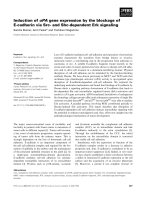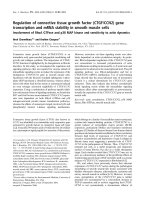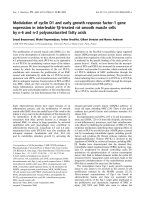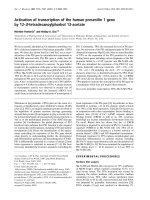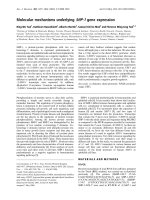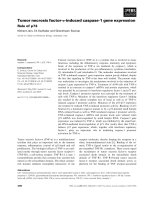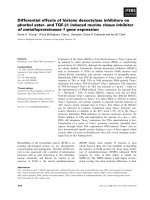Regulation of na+ h+ exchanger 1 (NHE 1) gene expression by mild oxidative stress
Bạn đang xem bản rút gọn của tài liệu. Xem và tải ngay bản đầy đủ của tài liệu tại đây (4.37 MB, 288 trang )
REGULATION OF Na
+
-H
+
EXCHANGER 1 (NHE-1) GENE
EXPRESSION BY MILD OXIDATIVE STRESS
CHANG KER XING
BSc (Honours)
A THESIS SUBMITTED FOR THE DEGREE OF DOCTOR OF
PHILOSOPHY
DEPARTMENT OF BIOCHEMISTRY
NATIONAL UNIVERSITY OF SINGAPORE
2009
Pg| 1
LIST OF FIGURES 6
LIST OF TABLE. 11
ACKNOWLEDGEMENTS 13
ABBREVIATIONS USED 14
SUMMARY OF THIS STUDY 16
PUBLICATIONS AND PRESENTATIONS 18
CHAPTER 1: INTRODUCTION 20
1.1 FREE RADICALS AND REACTIVE SPECIES 20
1.1.1 Overviewoffreeradicalsandtheirderivativereactivespecies 20
1.1.2 ReactiveOxygenSpecies 21
1.1.2 A Major types of free radicals and their derivatives 21
1.1.2 B Redox signaling 23
1.1.3 ReactiveNitrogenSpecies 24
1.1.3 A The production of NO from nitric oxide synthase 24
1.1.3 B NO and its derivatives 25
1.1.3 C Peroxynitrite 25
1.1.4 Theantioxidantsystem 26
1.1.5 Oxidativestress 27
1.1.6 TheNOXfamilyNADPHoxidases 28
1.1.7 Hydrogenperoxideasasignalingmolecule 32
1.2 REDOX REGULATION OF GENE EXPRESSION 35
1.2.1 BindingoftranscriptionfactorstoDNAisinfluencedbyredoxbalance
35
1.2.2 Transcriptionfactorsthatareresponsibleforgeneinductionmediated
byROS 36
1.2.2 A NF-κB 36
1.2.2 B AP-1 37
Pg| 2
1.2.2 C
HSF1 38
1.2.2 D Nrf2 40
1.2.3 GenerepressionmediatedbyROS 42
1.3
ROLES OF SUPEROXIDE AND HYDROGEN PEROXIDE IN CELL
SURVIVAL AND TUMORIGENESIS 43
1.4
SODIUM-HYDROGEN EXCHANGER 1 (NHE-1) 46
1.4.1 NHEandintracellularpHregulation 46
1.4.2 ThemammalianNHEfamily 47
1.4.3 PhysiologicalfunctionsofNHE‐1 48
1.4.3. A NHE-1 and myocardial diseases 48
1.4.3. B NHE-1 in tumor cells 48
1.4.3. C Regulation of cells’ volume during hypertonic stress 53
1.4.3. D NHE-1 as a cytoskeleton anchoring protein and signalplex 53
1.4.3. E NHE-1 and cell differentiation 53
1.4.4 RegulationofactivityandexpressionofNHE‐1 54
1.4.4. A Regulation of NHE-1 activity 54
1.4.4. B Transcriptional regulation of NHE-1 expression 58
1.5
AIM OF STUDY 61
CHAPTER 2: MATERIALS AND METHODS 62
2.1 MATERIALS 62
2.1.1 Chemicalsandreagents 62
2.1.2 Antibodies 63
2.1.3 Plasmids 64
2.1.4 Celllinesandcellculture 65
Pg| 3
2.2
METHODS 66
2.2.1 TreatmentofcellswithHydrogenperoxide(H
2
O
2
)andOther
Compounds 66
2.2.2 MammalianCellExpressionbyTransientTransfection 66
2.2.3 LuciferaseGeneReporterAssay 67
2.2.4 ChloramphenicolAcetylTransferase(CAT)assay 68
2.2.5 CaspaseActivityAssay 69
2.2.6 CellviabilityestimationbyCrystalVioletAssay 69
2.2.7 DNAFragmentationAssay 70
2.2.8 SDS‐PAGEandImmunoblotting 71
2.2.9 RNAinterference(RNAi) 73
2.2.10 Nuclear‐CytoplasmicFractionation 74
2.2.11 IntracellularpH(pH
i
)MeasurementandNHEactivityAssay 74
2.2.12 RNAIsolationandMeasurementofmRNAlevelsbyReal‐timePCR 76
2.2.13 ImmunofluorescenceAssayusingConfocalMicroscopy 77
2.2.14 ExtracellularH
2
O
2
measurementusingAmplexRedAssay 78
2.2.15 IntracellularROSMeasurementbyCM‐DCFDA 78
2.2.16 IntracellularNitricOxide(NO)MeasurementbyDAF‐FM 79
2.2.17 MorphologyStudies 80
2.2.18 ProteinDetermination 80
2.2.19 StatisticalAnalysis 80
CHAPTER 3: RESULTS 81
3.1 MILD OXIDATIVE STRESS INDUCED BY H
2
O
2
INHIBITS GENE
EXPRESSION OF NHE-1 INVOLVED AN EARLY OXIDATION PHASE 81
3.1.1 Todetermineanon‐toxicdoseofH
2
O
2
inL6ratmusclecell 81
3.1.2 H
2
O
2
down‐regulatesNHE‐1geneexpression 87
3.1.3 H
2
O
2
initiatesthesignalforNHE‐1promoterrepression 94
3.1.4 OxidationisinvolvedintheearlyphaseofNHE‐1promoterinhibition
mediatedbyH
2
O
2
103
Pg| 4
3.2
ACTIVATION OF CASPASE 3 AND 6 IS REQUIRED FOR MILD
OXIDATIVE STRESS-INDUCED DECREASE IN NHE-1 GENE EXPRESSION.115
3.2.1 CaspasesareinvolvedinthesustainedinhibitionofNHE‐1gene
expressionmediatedbyH
2
O
2
115
3.2.2 Caspases3and6areinvolvedintheH
2
O
2
‐mediatedinhibitionofNHE‐
1promoteractivity 120
3.2.3 Caspase3activityfoundinthenucleusisimportantforNHE‐1gene
regulationinducedbyH
2
O
2
126
3.2.4 Down‐regulationofNHE‐1proteinexpressioninducedbyH
2
O
2
is
mainlyattributedtotheinhibitionofNHE‐1genetranscription 135
NHE-1 0
β-actin 0
3.3 ACTIVATION OF CASPASES 3 AND 6 MEDIATED BY MILD OXIDATIVE
STRESS INVOLVES IRON 140
3.3.1 SustainedrepressionofNHE‐1mediatedbyH
2
O
2
isiron‐dependent140
3.4
DOWN-REGULATION OF NHE-1 PROMOTER ACTIVITY IS
DEPENDENT ON THE PRODUCTION OF PEROXYNITRITE 155
3.4.1 AninitialstimulusmediatedbyH
2
O
2
inducesatransientincreaseof
ONOO
‐
atalaterphasethatisresponsibleforNHE‐1generegulation 155
3.4.2 ONOO
‐
participatesinthedown‐regulationofNHE‐1geneexpression .
166
3.5
PRODUCTION OF ROS AT THE LATE PHASE IS DEPENDENT ON
CASPASE 3 AND MAY BE GENERATED IN THE NUCLEUS OF L6 CELL 178
3.5.1 TheproductionofthesecondROS/ONOO
‐
iscaspase3dependent. 178
3.5.2 TheproductionofONOO
‐
at12hourfollowingL6cellsexposureto
H
2
O
2
maybefromthecell’snucleus 180
3.5.3 NOX2andn‐NOSarefoundinL61.1cells 182
3.6
INCREASED HO-1 EXPRESSION AND ACTIVATION OF p38MAPK 185
Pg| 5
3.6.1
InductionofHO‐1byH
2
O
2
mayberesponsibleforthesustainedNHE‐1
generepression 185
3.6.2 Activationofp38MAPKpathwayisimportantforthedown‐regulation
ofNHE‐1promoteractivity 194
3.7
LOCALIZATION OF THE H
2
O
2
RESPONSE ELEMENT 206
3.7.1 AnAP‐2bindingsitefoundintheNHE‐1promoterregionis
responsibletoinducetheinhibitionofNHE‐1promoterbyH
2
O
2
207
3.8 PHYSIOLOGICAL IMPORTANCE OF NHE-1 GENE REGULATION 212
3.8.1 EffectofmildoxidativestressonNHE‐1:Theregulationof
intracellularpHandcellcycle 212
CHAPTER 4: DISCUSSION 220
4.1 NHE-1 GENE EXPRESSION IS REDOX-REGULATED 221
4.1.1 Down-regulation of NHE-1 gene expression by H
2
O
2
221
4.1.2 Thiol oxidation of an AP-2 or AP-2-like transcription factor could be
responsible for the initial inhibition of NHE-1 gene expression mediated by
H
2
O
2
222
4.2 ROLE OF CASPASES 3 AND 6 IN THE INHIBITION OF NHE-1
EXPRESSION BY MILD OXIDATIVE STRESS 225
4.3 IRON AND THE ACTIVATION OF CASPASES 3 AND 6 BY MILD
OXIDATIVE STRESS 232
4.3.1 Iron is required for the activation of caspases 3 and 6 by non-toxic
doses of H
2
O
2
232
4.3.2 Activation of HO-1: A possible mechanism involved in the increase
of labile iron pool (LIP) 234
4.4 INTRACELLULAR PRODUCTION OF ROS/ONOO
-
AT THE LATE PHASE
IS CRUCIAL FOR A SUSTAINED REPRESSION OF NHE-1 GENE EXPRESSION
240
4.5 NUCLEAR LOCALIZATION OF CASPASE 3 PROTEINS: FOR EFFICIENT
GENE REGULATION OF NHE-1 DURING MILD OXIDATIVE STRESS 243
Pg| 6
4.6
ACTIVATION OF P38MAPK PATHWAY INVOLVES IN THE DOWN-
REGULATION OF NHE-1 PROMOTER ACTIVITY 248
4.7 NHE-1 EXPRESSION AS AN IMPORTANT DETERMINANT FOR CELL
TRANSFORMATION: A POSSIBLE INITIATOR FOR TUMORIGENESIS? 251
4.8 CONCLUSION 255
REFERENCES 256
Pg| 7
LIST OF FIGURES
Figure A: Pathways of ROS production and clearance 22
Figure B: Structural organization of NOX protein family members 29
Figure C: Roles of H
2
O
2
in a mammalian cell 34
Figure D: Schematic illustration of the steps in transcription factors NF-kB, AP-1,
HSF1 and p53 activation that may be influenced by ROS and thiols-containing
molecules 39
Figure E: Redox-mediated activation of transcription factor Nrf2 41
Figure F: Schematic representation of the role of ROS in oncogenesis 45
Figure G: Topology of NHE-1 and its regulatory elements 57
Figure H: DNA sequence of the promoter/enhancer region of the human NHE 60
Figure 1: Establish non-toxic concentrations of H
2
O
2
in L61.1 cells 86
Figure 2: Illustration of a L61.1 cell stably expressing full length 1.1kb proximal
fragment of the mouse NHE-1 gene promoter inserted 5’ to the luciferase reporter
gene 87
Figure 3: Down-regulation of NHE-1 promoter activity by H
2
O
2
is dose-dependent .89
Figure 4: NHE-1 promoter repression by H
2
O
2
is truly a regulatory process and is not
due to the degradation of the luciferase proteins 91
Figure 5: Down-regulation of NHE-1 mRNA and protein expression by H
2
O
2
is dose-
dependent 93
Figure 6: Consumption of extracellular H
2
O
2
by L61.1 cells results in the inhibitory
effect of H
2
O
2
seen on NHE-1 promoter activity 96
Figure 7: NHE-1 promoter down-regulation was due to H
2
O
2
and not due to other
products present in the extracellular medium 99
Figure 8: Recovery of NHE-1 promoter activity and cell proliferation ability when
serum was re-introduced in L6 cells 102
Figure 9: βME dose response effect on H
2
O
2
-mediated NHE-1 promoter activity
repression 104
Pg| 8
Figure 10: Reducing agents, DTT and ME inhibited H
2
O
2
-mediated repression of
NHE-1 gene expression 106
Figure 11: Cellular reducing agents NAC and GSH rescued the inhibitory effect of
H
2
O
2
on NHE-1 promoter activity 108
Figure 12: Diamide dose response repression of NHE-1 expression 111
Figure 13: Thiol oxidizing agent diamide mimicked the effect of H
2
O
2
in the down-
regulation of NHE-1 gene expression 113
Figure 14: ME inhibited H
2
O
2
-mediated repression of NHE-1 gene expression if it
was added prior to H
2
O
2
incubation or maximally 5 hours post-H
2
O
2
treatment 114
Figure 15: Inhibition of NHE-1 gene expression by H
2
O
2
is caspases dependent 117
Figure 16: Reducing agent βME and pan-caspases inhibitor z-VAD-fmk rescue the
inhibition of NHE-1 gene expression by H
2
O
2
at different time points 118
Figure 17: Reducing agent βME but not pan-caspases inhibitor z-VAD rescues the
inhibition of NHE-1 gene expression by thiol-oxidant diamide 119
Figure 18: Caspases 1 and 10 are not activated by H
2
O
2
in L61.1 cells 121
Figure 19: H
2
O
2
induced activation of caspases 3 and 6 independent of the initiator
caspases 122
Figure 20: H
2
O
2
induced inhibition of NHE-1 promoter activity involves the
activation of caspases 3 and 6 124
Figure 21: siRNA gene silencing of caspases 3 and 6 abolished the inhibitory effect of
H
2
O
2
on NHE-1 promoter activity 125
Figure 22: H
2
O
2
-mediated increased in caspase 3 activity is more pronounced in the
nucleus than in the cytosol 127
Figure 23: Increase in cleaved caspase 3 activity and expression induced by H
2
O
2
is
more pronounced in the nucleus than cytosol of L61.1 cells 131
Figure 24: Increase in active caspase 3 in the nucleus post-H
2
O
2
treatment detected by
immunofluorescence 134
Figure 25: DNA transcriptional inhibitor actinomycin D increases caspase 3 activities
in L61.1 cells 136
Figure 26: Decrease of NHE-1 mRNA level induced by H
2
O
2
is of similar degree to
transcriptional inhibition by actinomycin D 137
Pg| 9
Figure 27: Down-regulation of NHE-1 protein expression by H
2
O
2
is mainly due to
the transcriptional repression of NHE-1 promoter 138
Figure 28: Summary diagram illustrating the contribution of transcription and post-
transcriptional event that result in the total decrease of NHE-1 protein expression
mediated by non-toxic doses of H
2
O
2
in L61.1 cells 139
Figure 29: Scavenging of HO• by HCOONa does not rescue the repression of NHE-1
promoter mediated by H
2
O
2
142
Figure 30: Chelating of iron by DFO inhibits the repression of NHE-1 promoter
mediated by H
2
O
2
145
Figure 31: Chelating of iron by DFO prevent the increase of caspases 3 and 6
activities mediated by H
2
O
2
146
Figure 32: Chelating of iron by phenanthroline rescue the decrease in NHE-1
promoter activity mediated by H
2
O
2
148
Figure 33: Chelating of iron by phenanthroline prevents the increase of caspases 3 and
6 activities mediated by H
2
O
2
149
Figure 34: Chelating of iron by DFP inhibits the repression of NHE-1 promoter
mediated by H
2
O
2
150
Figure 35: Activities of caspases 3 and 6 are required for FeCl
3
-induced NHE-1
promoter inhibition 154
Figure 36: Increased level of ROS production is detected at 2 hour and 12 hour post-
H
2
O
2
treatment 156
Figure 37: ONOO
-
is detected at 2 hour by DCFDA fluorophore after H
2
O
2
treatment
in L61.1 cells 158
Figure 38: Increase in DAF fluorescence is detected at 2 hour after H
2
O
2
treatment in
L61.1 cells 159
Figure 39: ONOO- at the concentrations of 150µM to 200µM generate similar level of
DCF fluorescence as 50µM H
2
O
2
at 14 hour in L61.1 cells 161
Figure 40: DCF fluorescence produced at 14 hour post-H
2
O
2
was abolished when
L61.1 cells were pre-treated with ONOO
-
decomposition catalyst FeTPPS 163
Figure 41: DAF fluorescence produced at 14 hour post-H
2
O
2
treatment was abolished
when L61.1 cells were pre-treated with ONOO
-
decomposition catalyst FeTPPS 165
Pg| 10
Figure 42: Breakdown of ONOO
-
and chelating of iron blocked the inhibition of
NHE-1 promoter activity mediated by H
2
O
2
167
Figure 43: Breakdown of ONOO
-
by FeTPPS prevents the decrease of NHE-1
promoter activity by different doses of H
2
O
2
168
Figure 44: Breakdown of ONOO
-
by FeTPPS prevents the inhibitory effects of H
2
O
2
on NHE-1 promoter activity from early part of the time kinetics 169
Figure 45: Breakdown of ONOO
-
by FeTPPS prevents the increase of caspases 3 and
6 activation mediated by 50µM H
2
O
2
171
Figure 46: Intracellular production of ONOO
-
by SIN-1 decreases NHE-1 promoter
activity 172
Figure 47: Treatment of L6.1 cells with extracellularly added ONOO
-
decreases NHE-
1 promoter activity in a dose dependent manner 173
Figure 48: Iron-chelation and ONOO
-
decomposition rescue the repression of NHE-1
promoter activity mediated by ONOO
-
174
Figure 49: Exogenously added ONOO
-
does not activate caspases 3 and 6 in L61.1
cells 176
Figure 50: ONOO
-
donor, SIN-1 activates caspases 3 177
Figure 51: Inhibiting the activities of caspase 3 by specific inhibitor and siRNA gene
silencing prevent the increase of DCF fluorescence at 14 hour following exposure of
L61.1 cells to H
2
O
2
179
Figure 52: Increase in the level of DCF fluorescence is detected in the cell nucleus
with H
2
O
2
treatment 181
Figure 53: NOX 2 is expressed in the nuclei of L61.1 cells 183
Figure 54: n-NOS is the predominant nitric oxide synthase found in L6 cells 184
Figure 55: H
2
O
2
induces the expression of HO-1 187
Figure 56: Time kinetic studies of HO-1 protein expression induced by H
2
O
2
and
ONOO
-
in L61.1 cells 188
Figure 57: H
2
O
2
increases HO-1 protein expression in both the cytosol and nucleus of
L61.1 cell 189
Figure 58: Silencing of HO-1 expression reduces the activation of caspases 3 and 6
induced by H
2
O
2
191
Pg| 11
Figure 59: Silencing of HO-1 expression reduces the inhibitory effect of NHE-1
promoter activity by H
2
O
2
193
Figure 60: H
2
O
2
increases the phosphorylation of p38 proteins at 2 and 4 hour in
L61.1 cells 195
Figure 61: Inhibition of ERK with U0126 does not rescue the decrease of NHE-1
promoter activity mediated by H
2
O
2
198
Figure 62: Inhibition of p38MAPK rescues H
2
O
2
-mediated NHE-1 promoter activity
down-regulation 200
Figure 63: Inhibition of p38MAPK rescues NHE-1 promoter activity repression by
H
2
O
2
and ONOO
-
202
Figure 64: Blocking p38 activity by SB202190 prevents the decrease of NHE-1
promoter from 9 hours after 50µM H
2
O
2
exposure in time kinetic study 204
Figure 65: Blocking p38 activity by SB202190 prevents the activation of caspase 3
induced by H
2
O
2
205
Figure 66: An AP-2 binding site found in the NHE-1 promoter region is responsible to
induce the inhibition of NHE-1 promoter by H
2
O
2
209
Figure 67: Over-expression of a dominant negative AP-2 (AP2) protein inhibited
NHE-1 gene expression 211
Figure 68: H
2
O
2
at 50µM decreases NHE-1 set-point pH but not the rate of H
+
extrusion 215
Figure 69: Pan-caspases inhibitor z-VAD prevents the drop of set-point pH induced
by 50µM H
2
O
2
218
Figure 70: Percentage of cells in G
2
/M arrest at indicated bolus addition of H
2
O
2
219
Figure 71: Caspase activation pathways: The extrinsic (death receptor-mediated) and
intrinsic ways to activate caspases during apoptosis 226
Figure 72: Regulation of cell progression, differentiation, activation and
cytoprotection by caspases requires the restricted cleavage of specific target proteins
229
Figure 73: Proposed model of the mechanism involved in the inhibition of NHE-1
gene expression by H
2
O
2
231
Figure 74: Classical endocytosis pathway of transferrin-receptor (TfR) 237
Pg| 12
Figure 75: Hypothetical pathway showing the involvement of ONOO
-
in the
inhibition of NHE-1 gene expression by an initial H
2
O
2
stimulus 242
Figure 76: Postulated pathway describing the generation of ONOO
-
in the nucleus
upon an initial H
2
O
2
trigger resulting in the inhibition of NHE-1 gene expression 246
Figure 77: Proposed model of pathways involved in H
2
O
2
-mediated NHE-1 gene
repression 254
LIST OF TABLES
Table 1: Examples of free radicals and their derivatives 20
Table 2: Characteristics of H
2
O
2
as second messenger 33
Table 3: Selected studies addressing the role of NHE-1 in tumorigenicity 52
Pg| 13
ACKNOWLEDGEMENTS
20 July 2002 was the day I first stepped into the “MVC-Lab” during my
undergraduate studies. I never knew cells had to be seeded on tissue culture plates for
experiments and micropipettes could be used to top up medium. From an ignorant
young science student to today, a “budding” researcher and mother-to-be, I must
thank a number of important people throughout the course of my study.
My greatest gratitude goes to my supervisor and boss, Associate Professor Marie-
Véronique Clément. Without her constant encouragements and patient guidance, I
would have dropped out from my PhD studies a few years back. I must thank Prof. for
her great understanding and tolerance during my times of bad hair days, especially
when my experimental results had gone the wrong way. I dedicate the phrase “merci
beaucoup, mon professeur” for Prof. who is more than a scientist, but also a teacher
that I respect and appreciate.
I would like to express my heartfelt appreciation to my dearest mentor, Dr Alan Prem
Kumar for his patient guidance, technical and moral support. Thanks for listening to
my complaints, and treating me to good meals during my birthdays and when I am
feeling down.
I would like to thank my seniors, Dr Sharon Lim and Dr Olivia Chao for guiding me
in the laboratory and teaching me about “Lab-sense”. Thanks for taking care of me
like elder sisters.
I am also thankful to Mui Khin, Huey fern, Soo fern, Dr Sufyan, Shirani, Aili, Charis,
Luole, Professor Shazib Pervaiz and many other good friends and lab-mates for being
good companions and help me in one way or another.
Thank you to my little junior, San Min for working together and continuing the
project, and Shi Jie for helping me during my thesis corrections period.
Last but not least, my hubby Jerry for his constant emotional and financial support
during these long years of my studies.
Lastly, to my parents, “I am finally done”.
Pg| 14
ABBREVIATIONS USED
AP-1 Activator Protein 1
AP-2 Activator Protein 2
AFC 7-amino-4-trifluoromethylcoumarin
BCECF 2´,7´-bis (2-carboxyethyl)-5,6-carboxyfluorescin
β-ME β-Mercaptoethanol
cDNA Complementary DNA
DME Dulbecco’s Modified Eagle’s Medium
DTT Dithiothreitol
DMSO Dimethyl Sulfoxide
DMTU Dimethyl Thio Uracil
DNA Deoxyribonucleic Acid
DFO Deferoxamine mesylate salt
DAF 4-amino-5-methylamino-2′,7′-difluorofluorescein
DCFDA 5-(and-6)-chloromethyl-2´,7´-dichlorodihydrofluorescein
diacetate acetyl ester
FBS Fetal Bovine Serum
FMK fluoromethylketone
FeTPPS 5,10,15,20-Tetrakis(4-sulfonatophenyl)porphyrinato Iron(III),
Chloride
GAPDH Glyceraldehyde-3-phosphate dehydrogenase
GSH Glutathione
H
2
O
2
Hydrogen Peroxide
HEPES 4-(-2-hydroxyethyl)-1-piperazineethanesulfonic acid
MAPK Mitogen Activated Protein Kinase
NFκB Nuclear Factor Kappa-B
Pg| 15
NHE Sodium Hydrogen Exchanger
NO Nitric Oxide
NOX NADPH oxidase
ONOO
-
Peroxynitrite
O
2
•-
Superoxide
OH
•
Hydroxyl radical
pH
i
Intracellular pH
PHEN o-Phenanthroline monohydrate
PDGF Platelet-derived growth factor
PKC Protein Kinase C
PIP
2
Phosphatidylinositol-4,5-bisphosphate
PI Propidium Iodide
RNA Ribonucleic Acid
RT-PCR Reverse Transcription-Polymerase Chain Reaction
ROS Reactive Oxygen Species
RNS Reactive Nitrogen Species
SDS-PAGE Sodium Dodecyl Sulphate-Polyacrylamide Gel Electrophoresis
siRNA Small Interfering RNA
Ser Serine
SOD Superoxide Dismutase
STS staurosporine
SIN-1 3-morpholinosydnonimine
Thr Threonine
Tyr Tyrosine
Pg| 16
SUMMARY OF THIS STUDY
Owing to the historical focus on gene induction, most reports on the regulation of
transcription factors by oxidative stress have described the activation of stress-
inducible genes in response to various stimuli. In contrast to the wealth of literature
on redox-dependent activation of transcription factors, very little is known in terms of
the oxidative repression of transcription machinery. Recently, our laboratory showed
that exposure of cells to non-toxic doses of H
2
O
2
led to the inhibition of the
ubiquituously expressed regulator of intracellular pH, NHE-1. Hence, the mechanism
of NHE-1 gene repression upon exposure of cells to non-apoptotic concentrations of
H
2
O
2
was investigated.
We show that the down-regulation of NHE-1 promoter activity and protein expression
was abrogated by the presence of reducing agents such as beta mercaptoethanol. The
pan-caspase inhibitor zVAD-fmk also blocked the effect of H
2
O
2
on NHE-1 promoter
activity and expression, but unlike beta mercaptoethanol, caspase inhibition was
ineffective in rescuing the early phase of NHE1 repression. Interestingly, the effect of
caspase inhibition was observed only after 9 hours of exposure to H
2
O
2
and
completely restored NHE-1 promoter activity by 18 to 24 hours. Using tetra-peptide
inhibitors of a variety of caspases and siRNA-mediated gene silencing, caspases 3 and
6 were identified as mediators of H
2
O
2
-induced NHE-1 repression, independent of
initiator caspase activation. Furthermore, incubation of cells with various iron
chelators, not only blocked the activities of caspases 3 and 6, but also affected NHE-1
promoter and protein expression in a manner similar to zVAD-fmk. Activated
caspases 3 was found in the nucleus of L6 cell upon stimulated by H
2
O
2
in the
absence of cell death. Interestingly, we also discovered that ONOO
-
plays an
Pg| 17
important role to regulate NHE-1 promoter activity as well. The production of
ONOO
-
appears to be dependent on the presence of iron. We speculate that
p38MAPK-HO-1 signaling pathway could be one pathway that releases the
intracellular iron that is required for the down-regulation of NHE-1 gene expression.
Taken together, our data show that a mild oxidative stress represses NHE-1 promoter
activity and expression via an early oxidation phase blocked by reducing agents and a
late phase requiring an iron-dependent increase in caspases 3 and 6 activities.
Moreover, these data suggest that iron-mediated activation of caspase 3 and 6 may be
a new pathway involved in the redox-mediated repression of gene transcription.
Pg| 18
PUBLICATIONS AND PRESENTATIONS
Publications:
Kumar AP*, Chang MK*, Fliegel L, Pervaiz S, Clement MV. Oxidative repression
of NHE1 gene expression involves iron-mediated caspase activity. Cell Death Differ
(2007). * Both authors contributed equally to this work.
Kumar AP*, Chang MK*, Pervaiz S and Clement MV. Hydrogen peroxide down-
regulates Na
+
/H
+
Exchanger 1 gene expression via non-death-related caspase 3
activity. Medimond International Proceedings (Conference paper, Switzerland) (2006).
* Both authors contributed equally to this work.
Kumar AP, Quake AL, Chang MKX, Zhou T, Lim KSY, Singh R, Hewitt RE, Salto-
Tellez M, Pervaiz S, Clement MV. Repression of the Na+/H+ exchanger 1 expression
by PPARγ activation is a potential new approach for specific inhibition of tumor cells’
growth in vitro and in vivo. Cancer Research (in press).
Poster presentations:
Chang MK, Kumar AP, Pervaiz S and Clement MV. Biphasic Effects of H
2
O
2
on
Na
+
/H
+
exchanger 1 (NHE-1) Gene Expression: Reminiscent for a Pro-apototic
Cellular Course Mediated by Redox Controlled AP2-like Transcription Factor.
Presented at Kyoto University-NUS International Symposium: Regulation of cell Fate
and cell function. Biopolis, Singapore (2005).
Chang MK, Kumar AP, Pervaiz S and Clement MV. Hydrogen peroxide down-
regulates Na
+
/H
+
Exchanger 1 gene expression via activation of caspase activity.
Presented at 20
th
IUBMB International Congress of Biochemistry and Molecular
Biology and 11th FAOBMB Congress. Kyoto, Japan (2006).
Chang MK, Kumar AP, Pervaiz S and Clement MV. Iron-dependent activation of
caspase 3 and 6: a new pathway involved in the redox inhibition of gene transcription.
Presented at
SFRBM 14
th
Annual Meeting. Renaissance Washington DC Hotel.
Washington, D.C. USA (2007). *Poster won a travel award.
Pg| 19
Oral presentations:
Chang MK, Kumar AP, Pervaiz S and Clement MV. Role of Transcription Factor,
AP-2 in H
2
O
2
-mediated Repression of the Na+/H+ exchanger 1 (NHE1) Gene
Expression.
Presented at Department of Biochemistry “Graduate Research Seminar”. National
University of Singapore (2005).
Chang MK, Kumar AP, Pervaiz S and Clement MV. Hydrogen peroxide down-
regulates Na
+
/H
+
Exchanger 1 gene expression via activation of caspases: A new
pathway involved in the redox inhibition of gene transcription.
Presented at Department of Biochemistry “Research in Progress” Seminar for post-
graduates. National University of Singapore (2008).
Chang MK, Kumar AP, Pervaiz S and Clement MV. Down-regulation of Na
+
/H
+
Exchanger 1 gene expression by hydrogen peroxide via activation of caspases: A new
pathway involved in the redox inhibition of gene transcription.
Presented at 1
st
Biochemistry Student Symposium. Clinical Research Centre, National
University of Singapore (2008).
.
Pg| 20
CHAPTER 1: INTRODUCTION
1.1 FREE RADICALS AND REACTIVE SPECIES
1.1.1 Overview of free radicals and their derivative reactive species
Free radical can be defined as any species capable of independent existence that
contains one or more unpaired electrons (Halliwell and Gutteridge, 1999; Koppenol,
1990). There is a variety of free radicals made in the living system and their chemical
reactivity varies over a wide spectrum. Some examples of free radicals and their
derivatives that are commonly involved in redox signaling are shown in Table 1.
RADICALS NON-RADICALS
Superoxide, O
2
•-
Hydrogen peroxide, H
2
O
2
Hydroxyl, OH• Peroxynitrite, ONOO
-
Nitric oxide, NO• Nitronium ion, NO
2
+
Nitrogen dioxide NO
2
• Hypochlorous acid, HOCl
Thiyl, RS•
Peroxyl, RO
2
•
Table 1: Examples of free radicals and their derivatives
Adapted from (Halliwell and Gutteridge, 1999).
Pg| 21
1.1.2 Reactive Oxygen Species
1.1.2 A Major types of free radicals and their derivatives
Reactive oxygen species (ROS) are oxygen-derived small molecules that include the
oxygen radicals as well as non-radicals. ROS are either oxidizing agents and/or are
easily converted into radicals (Bedard and Krause, 2007). ROS are produced by
mammalian cells as by-products of normal cellular metabolism from mitochondria,
peroxisomes and other cellular components (Archer et al., 2008; Bonekamp et al.,
2009; Li et al., 2008).
The superoxide anion, O
2
•-
is one of the most well-studied free radicals. It is formed
by univalent reduction of triplet-state molecular oxygen (Droge, 2002). O
2
•-
can be
produced by activation of the membrane-bound NADPH oxidase complex and
xanthine oxidase enzyme system in response to external stimuli (Kliubin and Gamalei,
1997; Margolin and Behrman, 1992). Xanthine oxidase metabolized xanthine or
hypoxanthine in the cytosol to produce O
2
•-
as illustrated in figure A (Droge, 2002;
Halliwell and Gutteridge, 1999). O
2
•-
can also be produced non-enzymically by auto-
oxidation reactions, especially in the presence of transition-metals ions (Halliwell and
Gutteridge, 1999). Biologically-important molecules such as glyceraldehydes, the
hormones adrenalin and noradrenalin, and thiol compounds such as cysteine are
sources of O
2
•-
(Halliwell and Gutteridge, 1999; Yan and Spallholz, 1993).
The enzymes superoxide dismutases (SOD) dismutate O
2
•-
to form H
2
O
2
in cells
(Frederiks and Bosch, 1997; Pigeolet et al., 1990), and H
2
O
2
can be converted to
highly reactive hydroxyl radical (OH•) in the presence of transition-metal iron (II)
ions (Fe
2+
) via Fenton reaction (Halliwell and Gutteridge, 1999) as shown:
Pg| 22
Fe
2+
+ H
2
O
2
Fe
3+
+ OH• + OH
-
Alternatively, H
2
O
2
can be converted into water (H
2
O) with the help of the enzymes
catalase or glutathione peroxidase (GP
X
) as shown in Figure A (Day, 2009; Urban et
al., 1995).
Figure A: Pathways of ROS production and clearance
Diagram adapted from (Droge, 2002).
(GSH: glutathione, GSSG: glutathione disulfide)
Pg| 23
1.1.2 B Redox signaling
The presence of ROS in cells have impacts on both physiological and pathological
pathways. Historically, ROS are treated as agents inducing cellular damage, having
deleterious effects and causing death in the biological systems. Indeed, ROS induce
an oxidative damage to cells when the level of ROS exceeds a certain threshold and
becomes toxic for the cell integrity (Galaris et al., 2008; Lu and Gong, 2009; Takano
et al., 2003). However, recent evidence supports the involvement of ROS in normal
physiological signaling pathways. For example, the adhesion of leukocytes to
endothelial cells is induced by ROS in particular H
2
O
2
and such cell adhesion can be
blocked by catalase (Roy et al., 1999). ROS are also implicated in insulin receptor
kinase activation (Azar et al., 2006; Schmid et al., 1999). H
2
O
2
has been shown to
activate insulin receptor through the inhibition of tyrosine phosphatases (Heffetz et al.,
1990). Numerous studies show that the MAPK signaling cascades are activated by
ROS (Bhat and Zhang, 1999; Liu et al., 2006; Ruiz-Ramos et al., 2005). In
oligodendrocyte, activation of extracellular signal-regulated kinase (ERK), p38MAPK,
and c-Jun N-terminal kinase (JNK) by H
2
O
2
has been demonstrated (Bhat and Zhang,
1999).
Pg| 24
1.1.3 Reactive Nitrogen Species
1.1.3 A The production of NO from nitric oxide synthase
Reactive nitrogen species (RNS) are nitrogen-containing oxidants. Like ROS, RNS
are divided into radicals and non-radicals. Among the RNS, nitric oxide (NO) and
ONOO
-
are most well-studied. L-arginine is the physiological precursor for the
formation of NO in higher organisms by the oxidation of one of the terminal guanido-
nitrogen atoms. This process is catalyzed by the enzyme nitric oxide synthase (NOS)
(Palmer et al., 1988). There are three structurally distinct isoforms of NOS identified
in mammalian cells, namely neuronal NOS (nNOS), endothelial NOS (eNOS) and
inducible NOS (iNOS) (Salerno et al., 2002). nNOS, also known as NOS1 is the first
NOS to be cloned and purified (Bredt and Snyder, 1990). nNOS is highly expressed in
brain tissues and NO as well as NO-derived oxygen species are suggested to modulate
the balance between the activities of kinases and phosphatases in neurofilament and
microtubule of neuronal cells (Rothe et al., 2002; Yang et al., 2002). iNOS which is
also known as NOS2, is inducible in many tissues by proinflammatory cytokines and
ROS (Chen et al., 2002; Chen et al., 2006; Simmons et al., 2002). Over-expression of
iNOS in cells increases the level of NO and NO-derived oxygen species and usually
results in cell toxicity and cell death (Fernandez-Gomez et al., 2005; Lee et al., 2007).
The third NOS, eNOS also known as NOS3, can be found mainly in the endothelium,
is also found in neurons and other tissues (Gobeil et al., 2002; Huang et al., 2000).
Unlike iNOS, both nNOS and eNOS are constitutively expressed (Gradini et al., 1999;
Xue et al., 1994).
